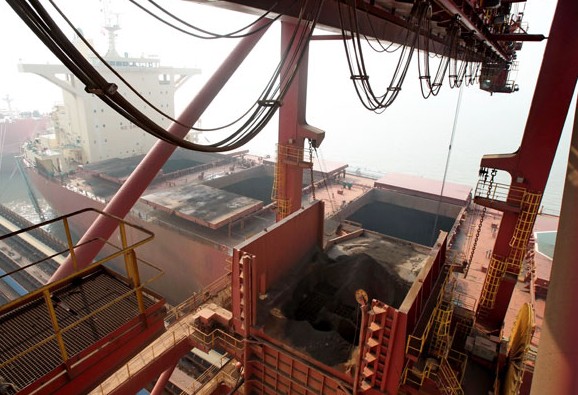

Imported iron ore is unloaded from a vessel in Nantong, Jiangsu province. Xu Congjun / For China Daily
New, cheap supplies from Australia, Brazil pushing global prices down
Surging global supplies of seaborne iron ore will challenge Chinese producers of the raw material for steel, probably forcing some higher-cost capacity in the country to close, according to BHP Billiton Ltd.
The gain in global production is being led by Australia and Brazil and their new, low-cost output will displace marginal suppliers in China, Michiel Hovers, vice-president of iron ore marketing at BHP, told an industry conference on Wednesday.
Vale SA, the world's biggest iron ore producer, plans to raise output by almost 50 percent by 2018, Claudio Alves, global director of marketing and sales, told the gathering in Singapore.
The biggest producers, including Vale, BHP, Rio Tinto Group and Fortescue Metals Group Ltd, have invested billions of dollars to expand output, betting on sustained growth in demand from China, the biggest buyer. Iron ore fell into a bear market in March amid forecasts for a global glut.
Fortescue wouldn't cut output even if prices extend declines as its costs are low, Zhuang Binjun, business development manager, said.
"Seaborne supply growth will come largely from Australia and Brazil," said Hovers. "This new supply will be low-cost seaborne and displace marginal supply from high-cost domestic Chinese producers and other lower-quality iron ore imports into China."
Slumping prices
Ore with 62 percent content delivered to Tianjin has fallen 21 percent so far this year to $106 a ton as of Tuesday, according to data from The Steel Index Ltd. The benchmark fell to $104.70 on March 10, the lowest level since 2012. While prices may be firmer over three months, there may be a drop below $100 over six months, toward $90, on the new supplies, Kamal Naqvi, global head of metals at Credit Suisse Group AG, told the conference.
If prices drop to $100, output in China may be hurt as domestic mines with high production costs are forced to cut output or close, according to the Bureau of Resources and Energy Economics, Australia's government forecaster. By comparison, Rio Tinto can be profitable above A $39 ($36), BHP's breakeven is A $41 ($38), and Fortescue's is A $56, UBS AG estimated.
Global seaborne supplies will increase 126 million tons to 1.38 billion tons this year, Morgan Stanley estimated in a May 5 report. That will increase the worldwide surplus to 79 million tons in 2014 from 1 million last year, the bank forecast.
"What's happening now is the major iron ore producers are bringing considerable new capacity," Alves said in an interview, forecasting a rise of about 120 million tons this year and a further 100 million tons in 2015. "Most of the tonnage is very competitive," he said.
Vale's expansion
Production at the Rio de Janeiro-based company will rise to about 453 million tons in 2018 compared with 306 million tons last year, Alves told the conference. Vale's average cost of production in Brazil is $21 to $22 a ton, he said.
"It takes time to absorb all this pickup in iron ore supply," said Alves, forecasting China's imports will be more than 900 million tons this year from 820 million tons. "It will make some pressure in terms of price, create some volatility."
The Tianjin benchmark fell for a fifth month in April, the longest losing run since August 2012, as growth in China slowed and seaborne supplies rose. The price will drop to $100 in the fourth quarter, according to Goldman Sachs Group Inc.
Regulator‘s iron ore financing checkup shakes market
2014-04-30China iron ore port stockpile up 1.11 pct
2014-04-02China‘s imported iron ore stockpiles rise for 6th week
2014-03-26China seeks more influence in setting iron ore prices
2014-03-24Prices of imported iron ore slide
2014-03-11Imported iron ore stockpiles at 16-month high
2014-02-25Copyright ©1999-2018
Chinanews.com. All rights reserved.
Reproduction in whole or in part without permission is prohibited.